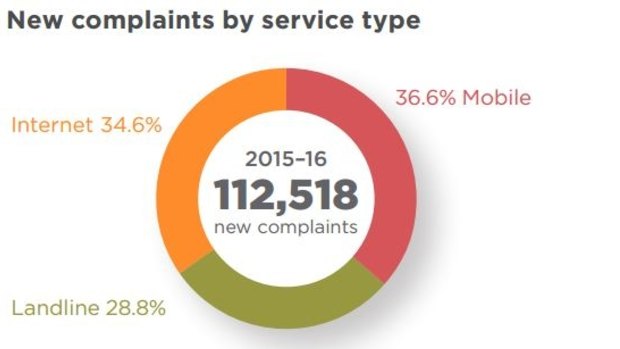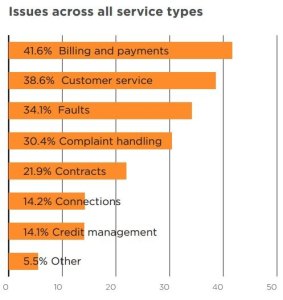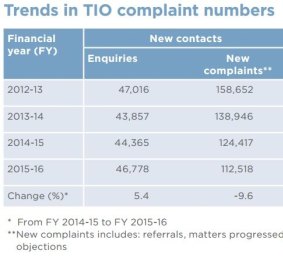- Business
- Consumer affairs
This was published 7 years ago
Telecommunications Ombudsman finds internet complaints increase as mobile complaints decline
By Lucy Cormack
Complaints about internet services and providers of the National Broadband Network rose by nearly 100 per cent in the past financial year, while billing, payments and faults were the biggest source of individual complaints, according to the Telecommunications Industry Ombudsman.
In its 2015-16 annual report, the TIO revealed new complaints about faults on NBN services jumped by 147.8 per cent, complaints about NBN connections rose by 63.2 per cent and general complaints about internet services jumped by 22 per cent.
Overall new complaints to the ombudsman decreased 9.6 per cent to 112,518, compared to the previous year.Victorians filed the most complaints, followed by South Australia, the ACT, NSW, Queensland, Tasmania, Western Australia and the Northern Territory.

Complaints about mobile services reduced in the past year by more than 28 per cent.
"While our complaints about the NBN service have doubled, the number of people connected to the NBN has more than doubled, as a result of the accelerating roll out," said ombudsman Judi Jones.
"The NBN is a major infrastructure rollout, so it won't always go smoothly to start. But, the fact is, the rate of complaints compared to the installation of services is declining, so it's a good/bad story."
Ms Jones said NBN-related complaints represent almost 12 per cent of those made to the TIO, detailing "delays in connections to the network, faults including unusable services, and dropout of services ... which is of concern."
An NBN spokeswoman said that the number of serviceable premises had more than doubled to almost 1.2 million from 485,000 in the previous financial year.

New complaints are classified according to one of three service types: mobile, landline or internet.Credit: TIO
"With this rapid increase in end users and construction activity, an increase in the number of issues reported to the TIO is to be expected," she said, adding that the NBN would continue to work towards improving customer satisfaction.
Complaints data from five service providers was detailed in the TIO report, including Telstra, Optus, Vodafone, iiNet and TPG, accounting for more than 83 per cent of new complaints.

The ranking of the top five new complaint issues is in the same order as last year. Credit: TIO
Billing and payments, customer service, faults, complaint handling and contracts were the most common complaints across all service types.
Among the telcos, iiNet recorded the largest increase in complaints about all services types, which jumped by 48.2 per cent.

Over the past five years changes to telecommunications regulations and substantial investment have driven a downward trend in new complaints to the TIO.Credit: TIO
TPG Telecommunications, which last year completed a successful $1.56 billion takeover of iiNet, experienced a complaints increase of 7.4 per cent.
Craig Levy, TPG's chief operations officer, said iiNet's internet complaints were largely linked to the growth of NBN services, as well as more than 59 mass service disruptions.
"We have also made changes to our policy on credits, which previously were provided without reason...so maybe historically customers found it easier to get a credit, and now if they don't they will go through the TIO."
Mr Levy said TPG had also fallen victim to a Telstra mass service disruption, in particular between May and October this year.
"Under this kind of disruption, customers experience prolonged installation and restoration times, because of the reliance on Telstra's workforce."
In line with a continuing five-year decline, complaints about mobile services reduced in the past year by more than 28 per cent, revealing an overall decline in complaints about coverage, excess data and roaming charges.
"Mobile service providers are doing better by investing in new infrastructure, but they have also got plans that better match the way we use our mobile phones," Ms Jones said.
Telstra reported an overall drop in complaints of 3.2 per cent, which "would have been even sharper had it not been for [an] increase in complaints about internet services," the TIO said.
A Telstra spokesperson said it maintained a "strong focus" on improving the customer experience.
Meanwhile, Optus experienced an 18.2 per cent increase in complaints, with mobile services the only category to drop slightly.
"... Over the last three months we have seen improvements due to ... network upgrades ... increased focus on customer service ... additional field technicians and improved management of exchange capacity," an Optus spokesperson said.
Vodafone received the best report card, successfully reducing its new complaints by 59.5 per cent since last year.
A Vodafone spokesperson said the improvement reflected its transformation to a "world-class 4G network," which now reaches 22 million Australians.
"We have looked at every aspect of the customer life cycle ... to see how we can help build usage awareness and confidence to minimise bill shock."